ECU TOYOTA HIGHLANDER 2017 XU50 / 3.G Owner's Manual
[x] Cancel search | Manufacturer: TOYOTA, Model Year: 2017, Model line: HIGHLANDER, Model: TOYOTA HIGHLANDER 2017 XU50 / 3.GPages: 732, PDF Size: 12.34 MB
Page 53 of 732
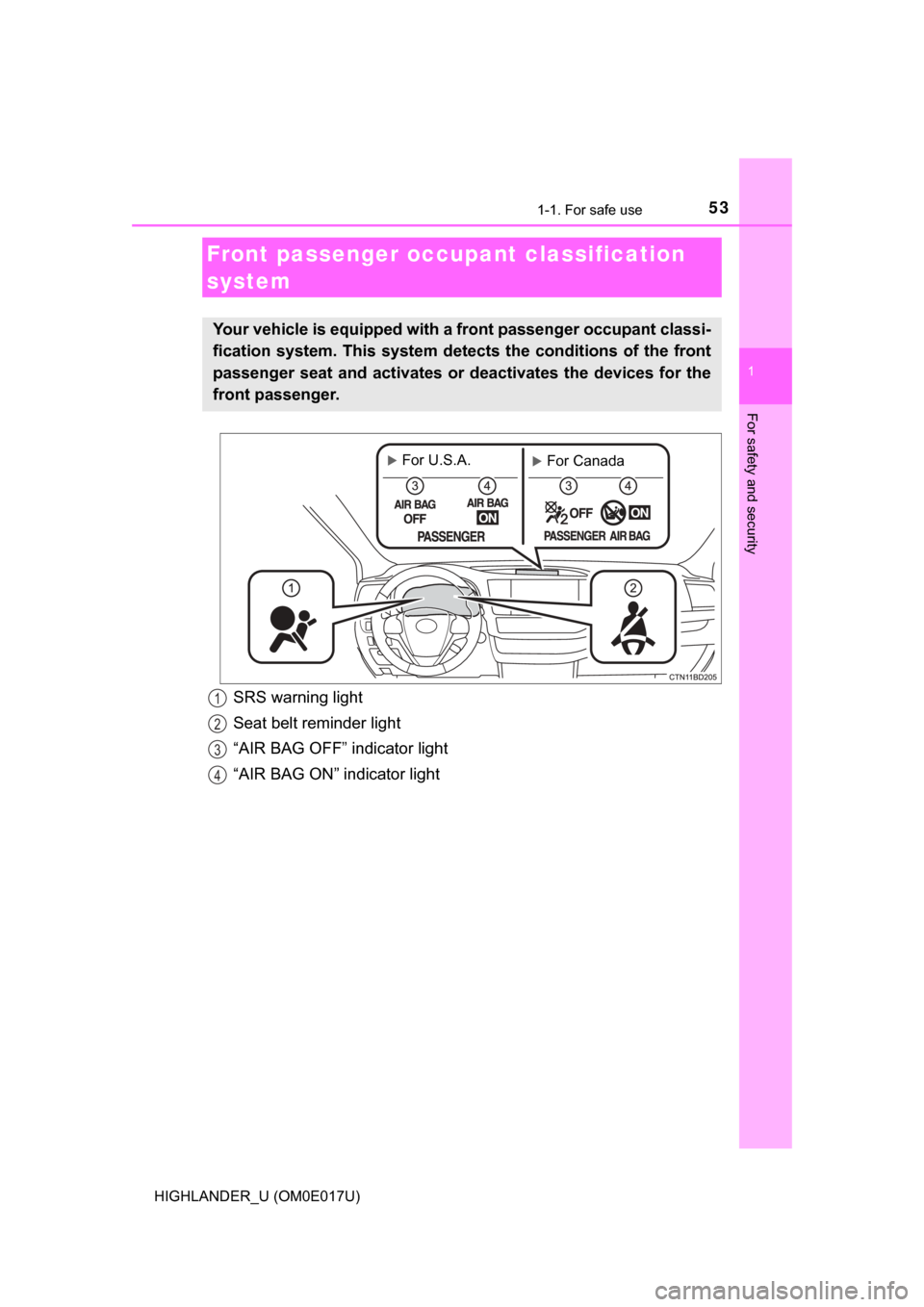
531-1. For safe use
1
For safety and security
HIGHLANDER_U (OM0E017U)
Front passenger occupant classification
system
Your vehicle is equipped with a front passenger occupant classi-
fication system. This system detects the conditions of the front
passenger seat and activates or deactivates the devices for the
front passenger.
For Canada For U.S.A.
SRS warning light
Seat belt reminder light
“AIR BAG OFF” indicator light
“AIR BAG ON” indicator light1
2
3
4
Page 55 of 732
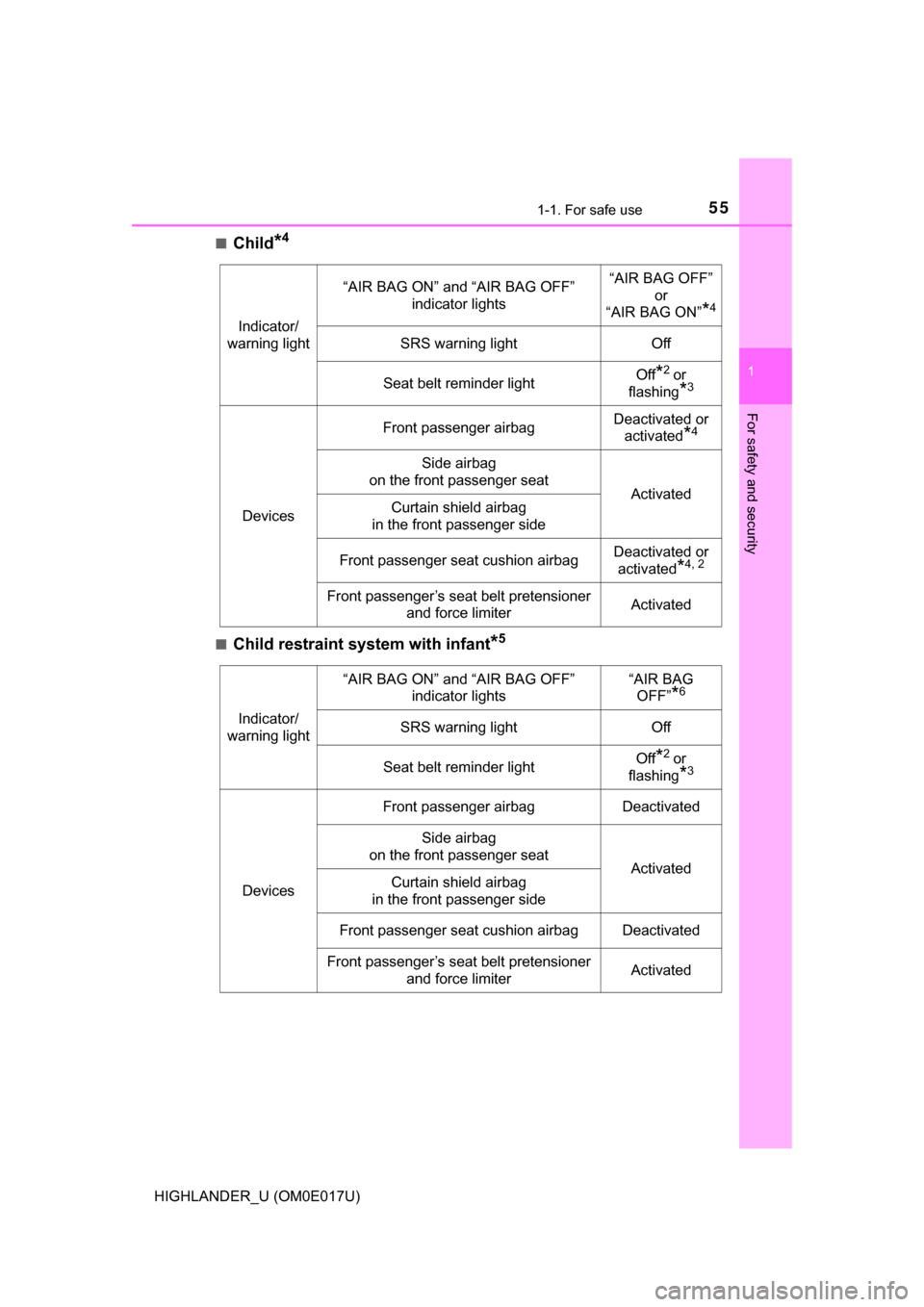
551-1. For safe use
1
For safety and security
HIGHLANDER_U (OM0E017U)■
Child*4
■Child restraint system with infant*5
Indicator/
warning light
“AIR BAG ON” and “AIR BAG OFF”
indicator lights“AIR BAG OFF” or
“AIR BAG ON”
*4
SRS warning lightOff
Seat belt reminder lightOff*2 or
flashing
*3
Devices
Front passenger airbagDeactivated or activated
*4
Side airbag
on the front passenger seat
ActivatedCurtain shield airbag
in the front passenger side
Front passenger seat cushion airbagDeactivated or activated
*4, 2
Front passenger’s seat belt pretensioner and force limiterActivated
Indicator/
warning light
“AIR BAG ON” and “AIR BAG OFF” indicator lights“AIR BAG OFF”
*6
SRS warning lightOff
Seat belt reminder lightOff*2 or
flashing
*3
Devices
Front passenger airbagDeactivated
Side airbag
on the front passenger seat
ActivatedCurtain shield airbag
in the front passenger side
Front passenger seat cushion airbagDeactivated
Front passenger’s seat belt pretensioner and force limiterActivated
Page 57 of 732
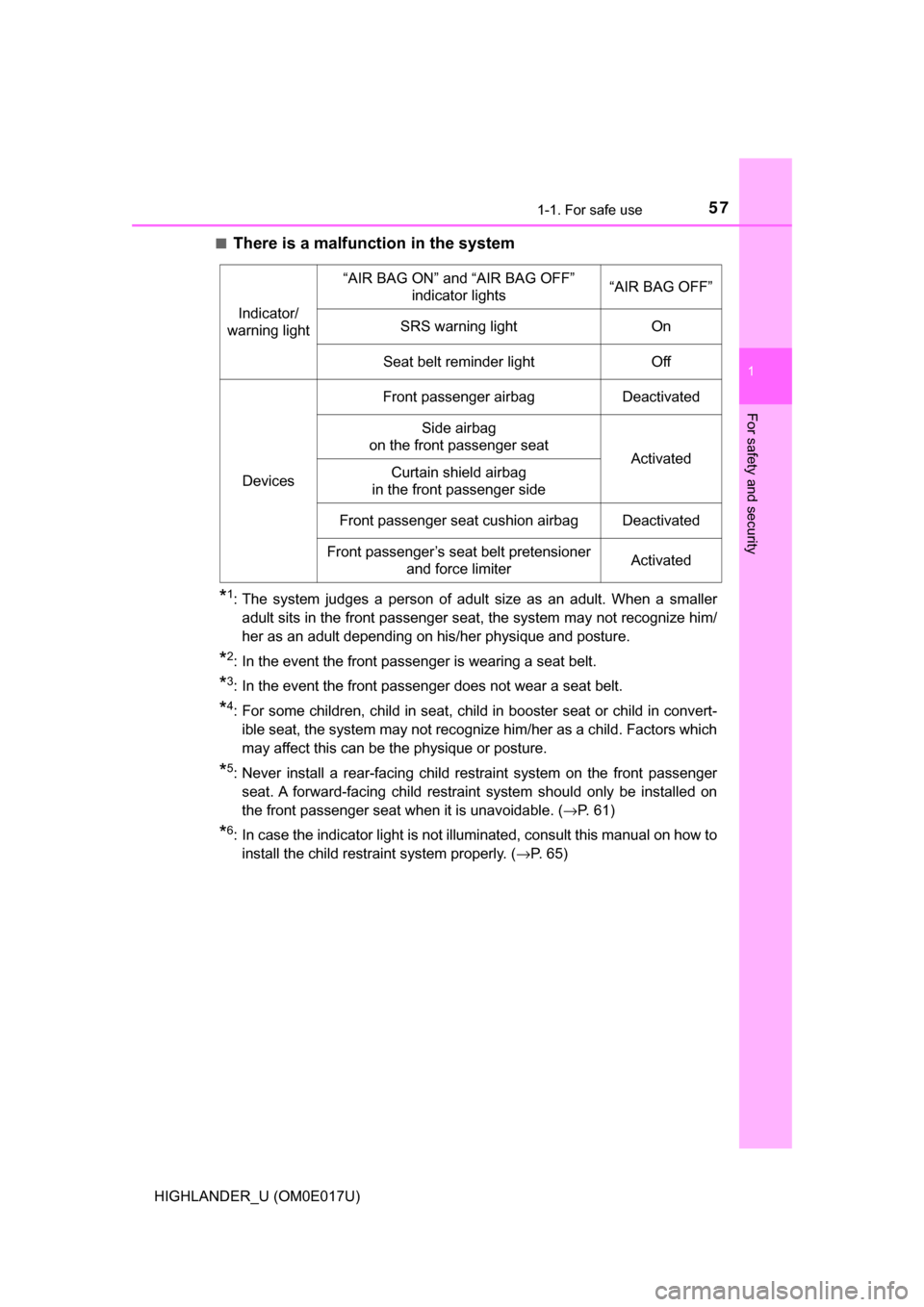
571-1. For safe use
1
For safety and security
HIGHLANDER_U (OM0E017U)■
There is a malfunction in the system
*1: The system judges a person of adult size as an adult. When a smaller
adult sits in the front passenger seat, the system may not recognize him/
her as an adult depending on his/her physique and posture.
*2: In the event the front passenger is wearing a seat belt.
*3: In the event the front passenger does not wear a seat belt.
*4: For some children, child in seat, child in booster seat or child in convert-ible seat, the system may not recognize him/her as a child. Factors which
may affect this can be the physique or posture.
*5: Never install a rear-facing child restraint system on the front passengerseat. A forward-facing child restraint system should only be installed on
the front passenger seat when it is unavoidable. ( →P. 61)
*6: In case the indicator light is not illuminated, consult this manual on how to
install the child restraint system properly. ( →P. 65)
Indicator/
warning light
“AIR BAG ON” and “AIR BAG OFF” indicator lights“AIR BAG OFF”
SRS warning lightOn
Seat belt reminder lightOff
Devices
Front passenger airbagDeactivated
Side airbag
on the front passenger seat
ActivatedCurtain shield airbag
in the front passenger side
Front passenger seat cushion airbagDeactivated
Front passenger’s seat belt pretensioner and force limiterActivated
Page 59 of 732
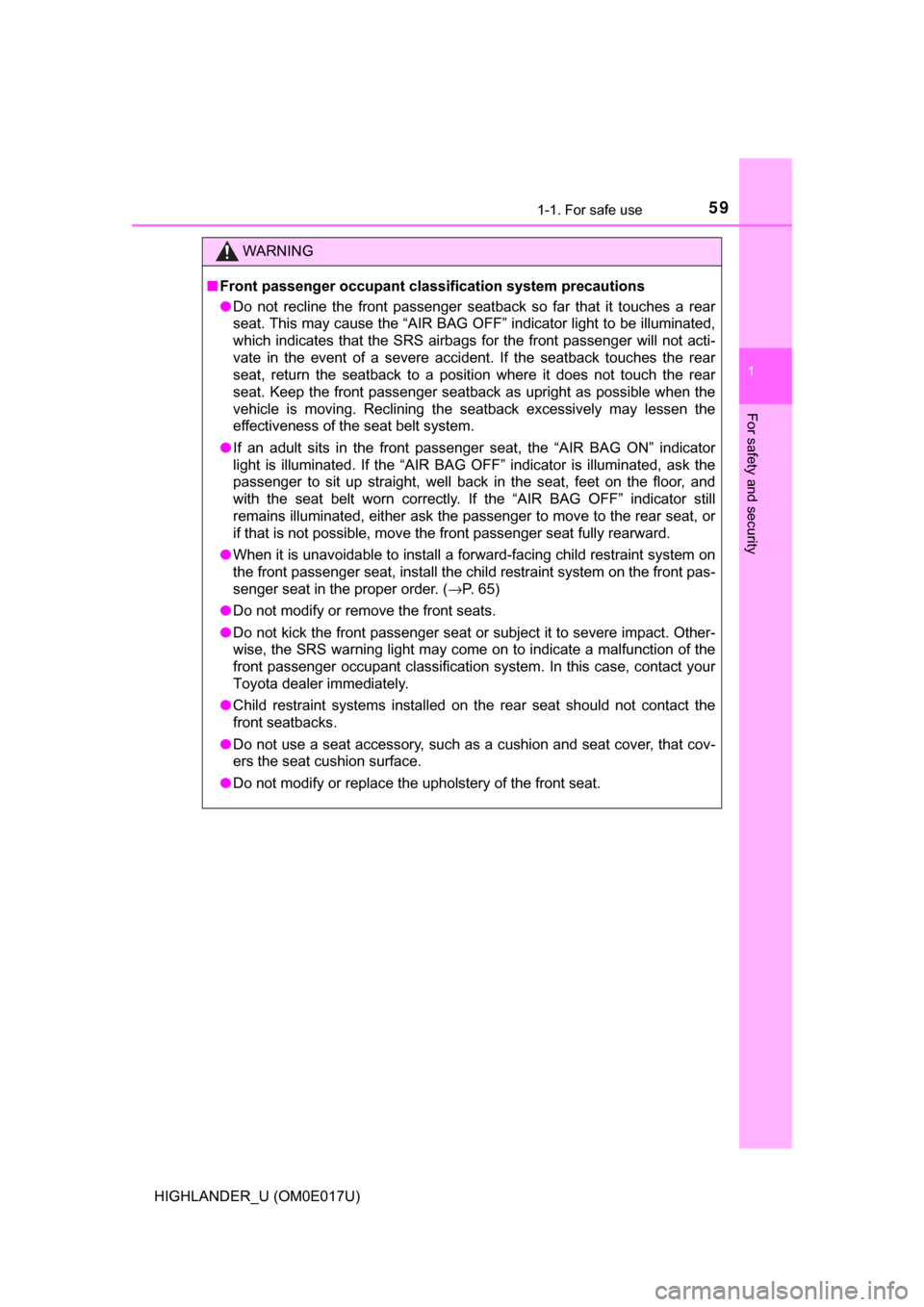
591-1. For safe use
1
For safety and security
HIGHLANDER_U (OM0E017U)
WARNING
■Front passenger occupant classi fication system precautions
● Do not recline the front passenger seatback so far that it touches a rear
seat. This may cause the “AIR BAG OFF” indicator light to be illuminated,
which indicates that the SRS airbags for the front passenger will not acti-
vate in the event of a severe accident. If the seatback touches the rear
seat, return the seatback to a position where it does not touch the rear
seat. Keep the front passenger seatback as upright as possible when the
vehicle is moving. Reclining the seatback excessively may lessen the
effectiveness of the seat belt system.
● If an adult sits in the front passenger seat, the “AIR BAG ON” indicator
light is illuminated. If the “AIR BAG OFF” indicator is illuminated, ask the
passenger to sit up straight, well back in the seat, feet on the floor, and
with the seat belt worn correctly. If the “AIR BAG OFF” indicator still
remains illuminated, either ask the passenger to move to the rear seat, or
if that is not possible, move the front passenger seat fully rearward.
● When it is unavoidable to install a forward-facing child restraint system on
the front passenger seat, install the child restraint system on the front pas-
senger seat in the proper order. ( →P. 65)
● Do not modify or remove the front seats.
● Do not kick the front passenger seat or subject it to severe impact. Other-
wise, the SRS warning light may come on to indicate a malfunction of the
front passenger occupant classification system. In this case, contact your
Toyota dealer immediately.
● Child restraint systems installed on the rear seat should not contact the
front seatbacks.
● Do not use a seat accessory, such as a cushion and seat cover, that cov-
ers the seat cushion surface.
● Do not modify or replace the upholstery of the front seat.
Page 61 of 732
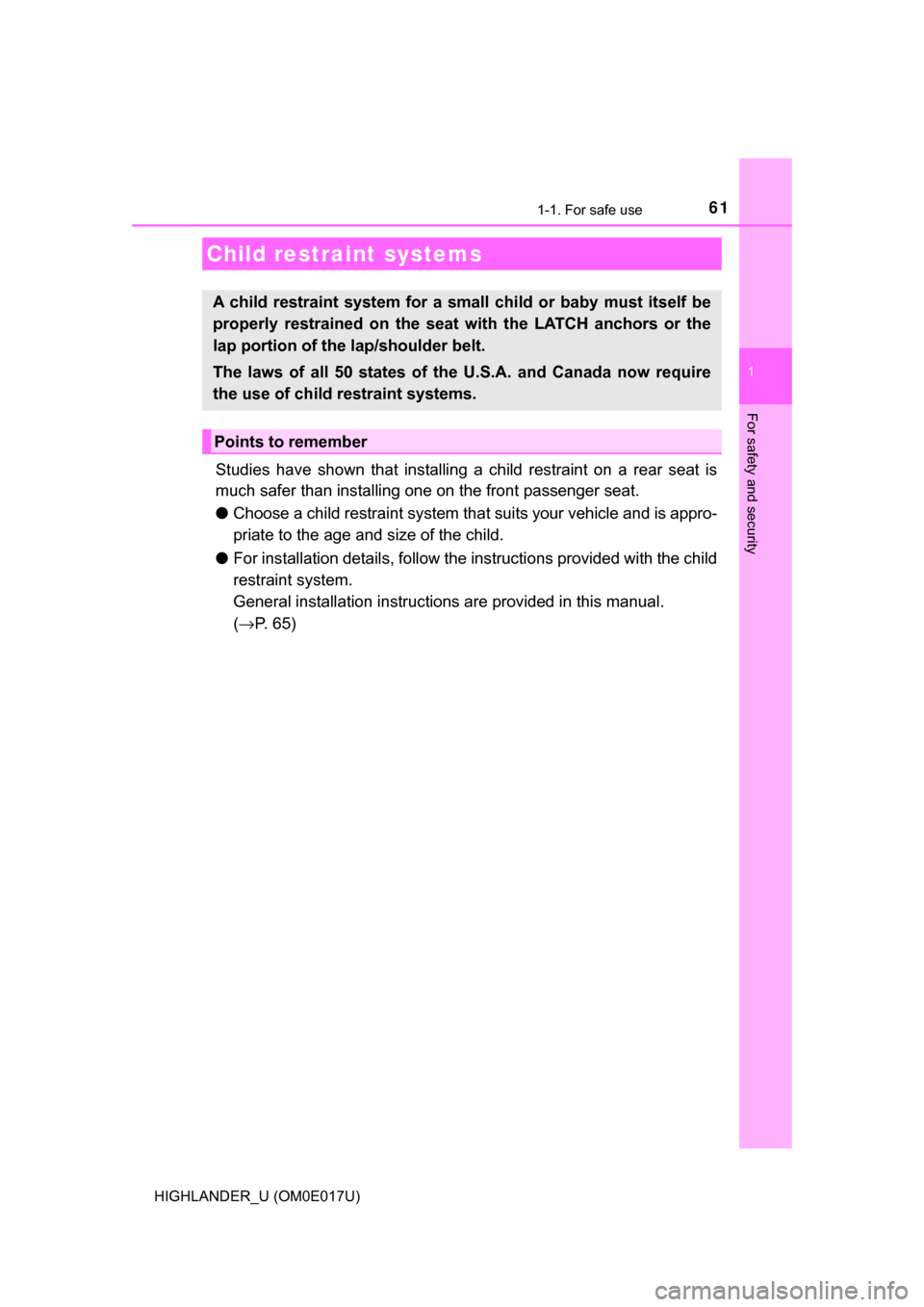
611-1. For safe use
1
For safety and security
HIGHLANDER_U (OM0E017U)
Studies have shown that installing a child re straint on a rear seat is
much safer than installing one on the front passenger seat.
● Choose a child restraint system that suits your vehicle and is appro-
priate to the age and size of the child.
● For installation details, follow the instructions provided with the child
restraint system.
General installation instructions are provided in this manual.
( → P. 65)
Child restraint systems
A child restraint system for a small child or baby must itself be
properly restrained on the seat with the LATCH anchors or the
lap portion of the lap/shoulder belt.
The laws of all 50 states of the U.S.A. and Canada now require
the use of child restraint systems.
Points to remember
Page 63 of 732
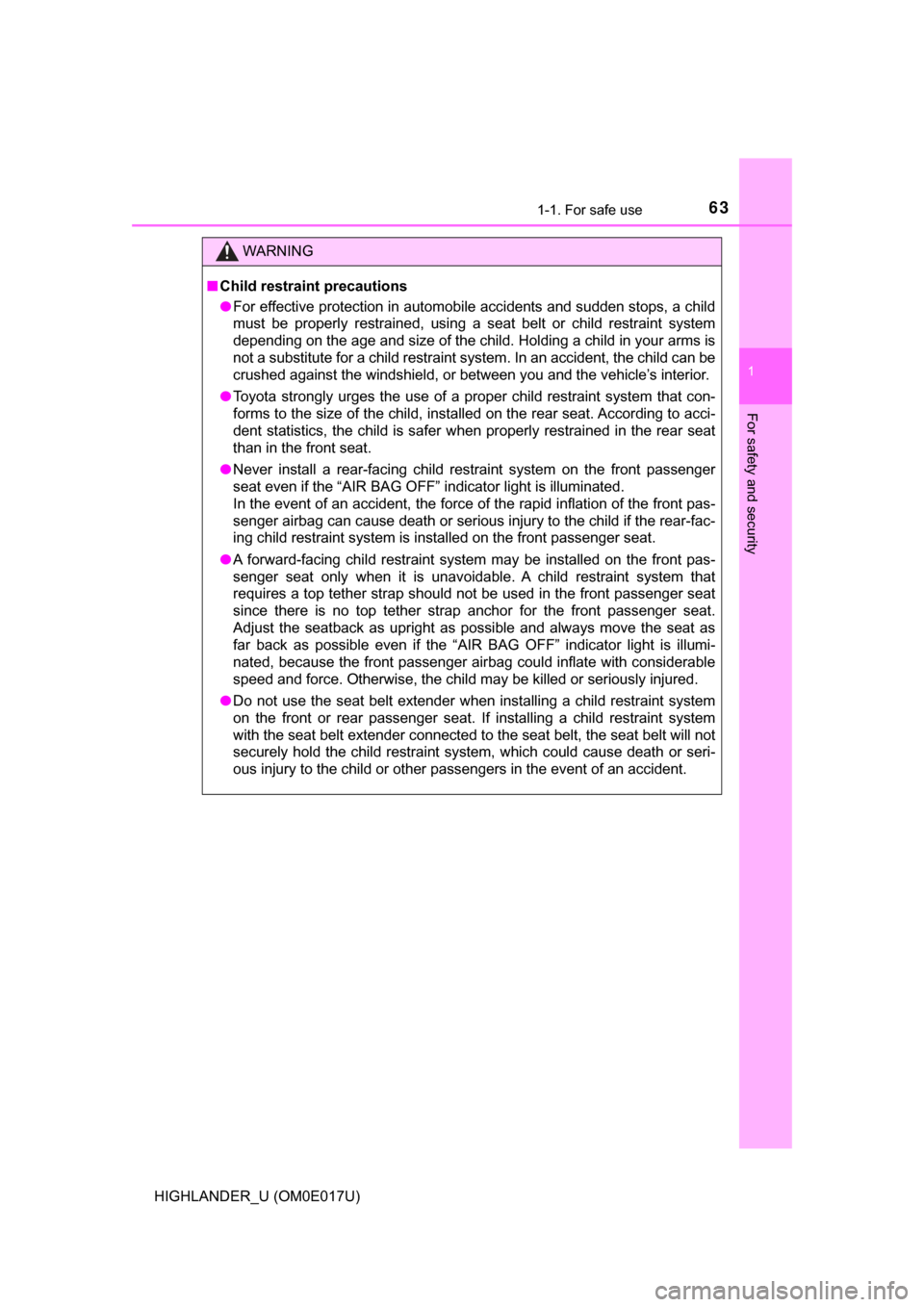
631-1. For safe use
1
For safety and security
HIGHLANDER_U (OM0E017U)
WARNING
■Child restraint precautions
● For effective protection in automobile accidents and sudden stops, a child
must be properly restrained, using a seat belt or child restraint system
depending on the age and size of the child. Holding a child in your arms is
not a substitute for a child restraint system. In an accident, the child can be
crushed against the windshield, or between you and the vehicle’s interior.
● Toyota strongly urges the use of a proper child restraint system that con-
forms to the size of the child, installed on the rear seat. According to acci-
dent statistics, the child is safer when properly restrained in the rear seat
than in the front seat.
● Never install a rear-facing child restraint system on the front passenger
seat even if the “AIR BAG OFF” indicator light is illuminated.
In the event of an accident, the force of the rapid inflation of the front pas-
senger airbag can cause death or serious injury to the child if the rear-fac-
ing child restraint system is installed on the front passenger seat.
● A forward-facing child restraint system may be installed on the front pas-
senger seat only when it is unavoidable. A child restraint system that
requires a top tether strap should not be used in the front passenger seat
since there is no top tether strap anchor for the front passenger seat.
Adjust the seatback as upright as possible and always move the seat as
far back as possible even if the “AIR BAG OFF” indicator light is illumi-
nated, because the front passenger airbag could inflate with considerable
speed and force. Otherwise, the child may be killed or seriously injured.
● Do not use the seat belt extender when installing a child restraint system
on the front or rear passenger seat. If installing a child restraint system
with the seat belt extender connected to the seat belt, the seat belt will not
securely hold the child restraint system, which could cause death or seri-
ous injury to the child or other passengers in the event of an accident.
Page 64 of 732
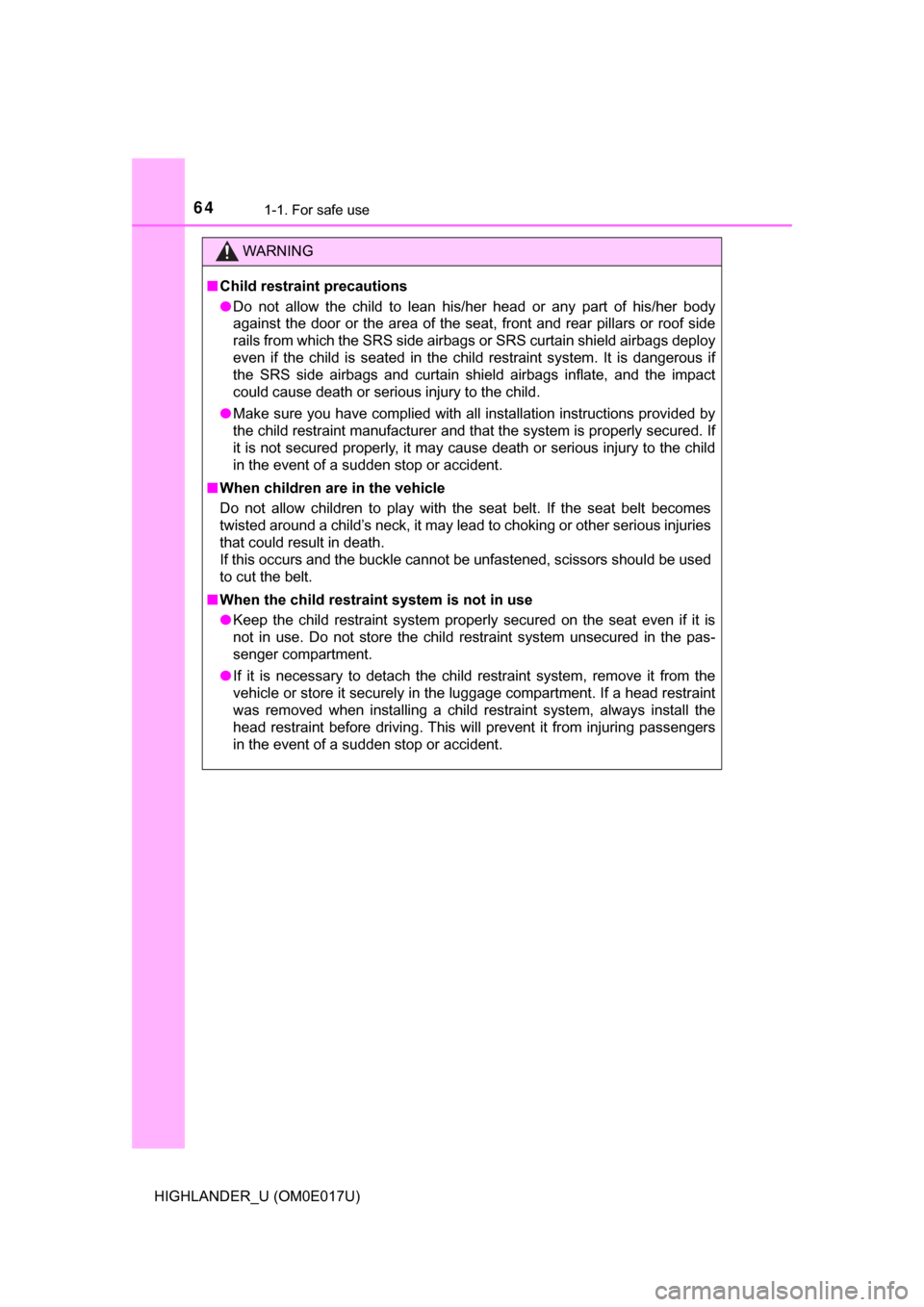
641-1. For safe use
HIGHLANDER_U (OM0E017U)
WARNING
■Child restraint precautions
● Do not allow the child to lean his/her head or any part of his/her body
against the door or the area of the seat, front and rear pillars or roof side
rails from which the SRS side airbags or SRS curtain shield airbags deploy
even if the child is seated in the child restraint system. It is dangerous if
the SRS side airbags and curtain shield airbags inflate, and the impact
could cause death or serious injury to the child.
● Make sure you have complied with all installation instructions provided by
the child restraint manufacturer and that the system is properly secured. If
it is not secured properly, it may cause death or serious injury to the child
in the event of a sudden stop or accident.
■ When children are in the vehicle
Do not allow children to play with the seat belt. If the seat belt becomes
twisted around a child’s neck, it may lead to choking or other serious injuries
that could result in death.
If this occurs and the buckle cannot be unfastened, scissors should be used
to cut the belt.
■ When the child restraint system is not in use
● Keep the child restraint system properly secured on the seat even if it is
not in use. Do not store the child restraint system unsecured in the pas-
senger compartment.
● If it is necessary to detach the child restraint system, remove it from the
vehicle or store it securely in the luggage compartment. If a head restraint
was removed when installing a child restraint system, always install the
head restraint before driving. This will prevent it from injuring passengers
in the event of a sudden stop or accident.
Page 65 of 732
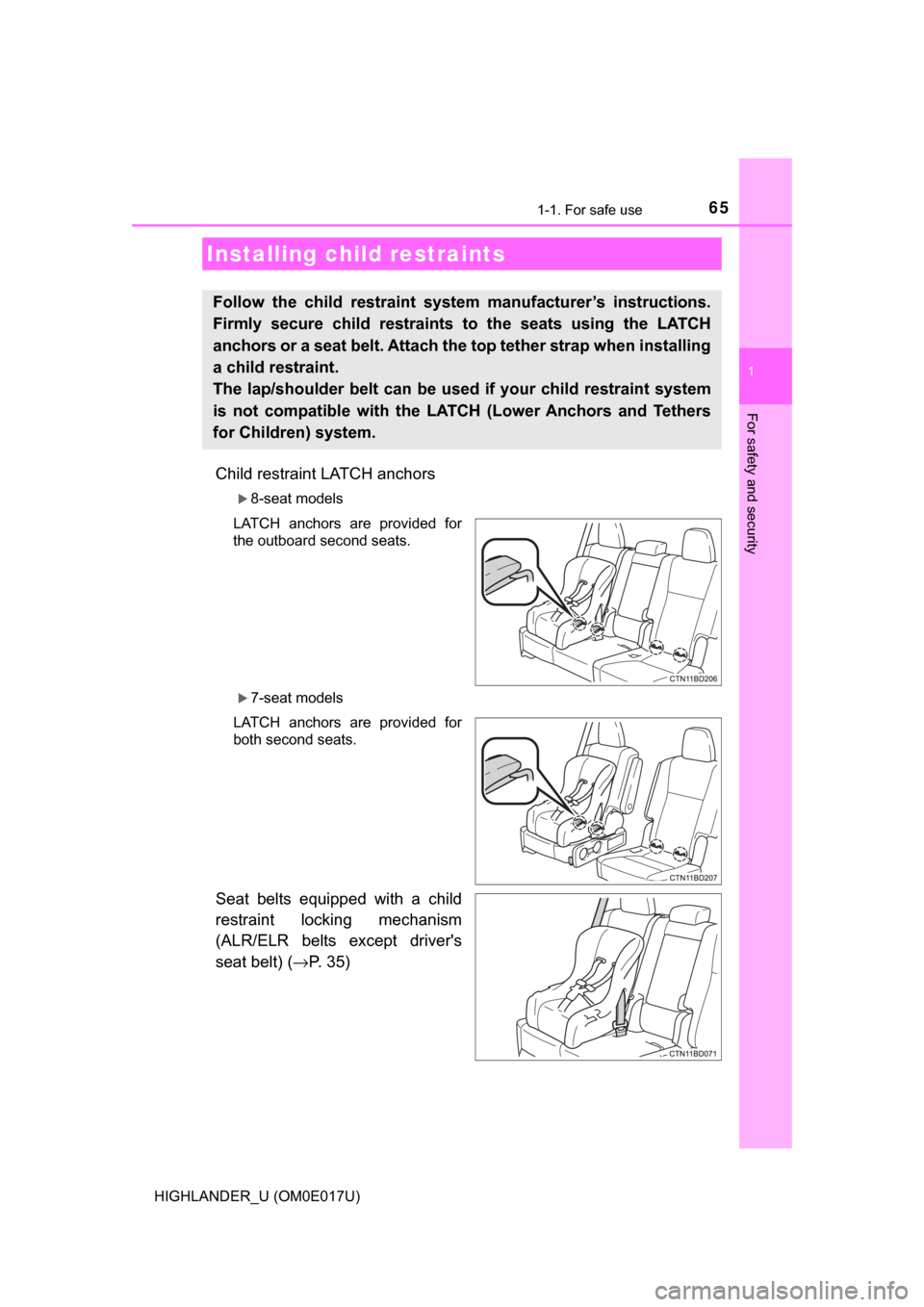
651-1. For safe use
1
For safety and security
HIGHLANDER_U (OM0E017U)
Child restraint LATCH anchors
8-seat models
LATCH anchors are provided for
the outboard second seats.
7-seat models
LATCH anchors are provided for
both second seats.
Seat belts equipped with a child
restraint locking mechanism
(ALR/ELR belts except driver's
seat belt) ( →P. 35)
Installing child restraints
Follow the child restraint system manufacturer’s instructions.
Firmly secure child restraints to the seats using the LATCH
anchors or a seat belt. Attach the top tether strap when installing
a child restraint.
The lap/shoulder belt can be used if your child restraint system
is not compatible with the LATCH (Lower Anchors and Tethers
for Children) system.
Page 67 of 732
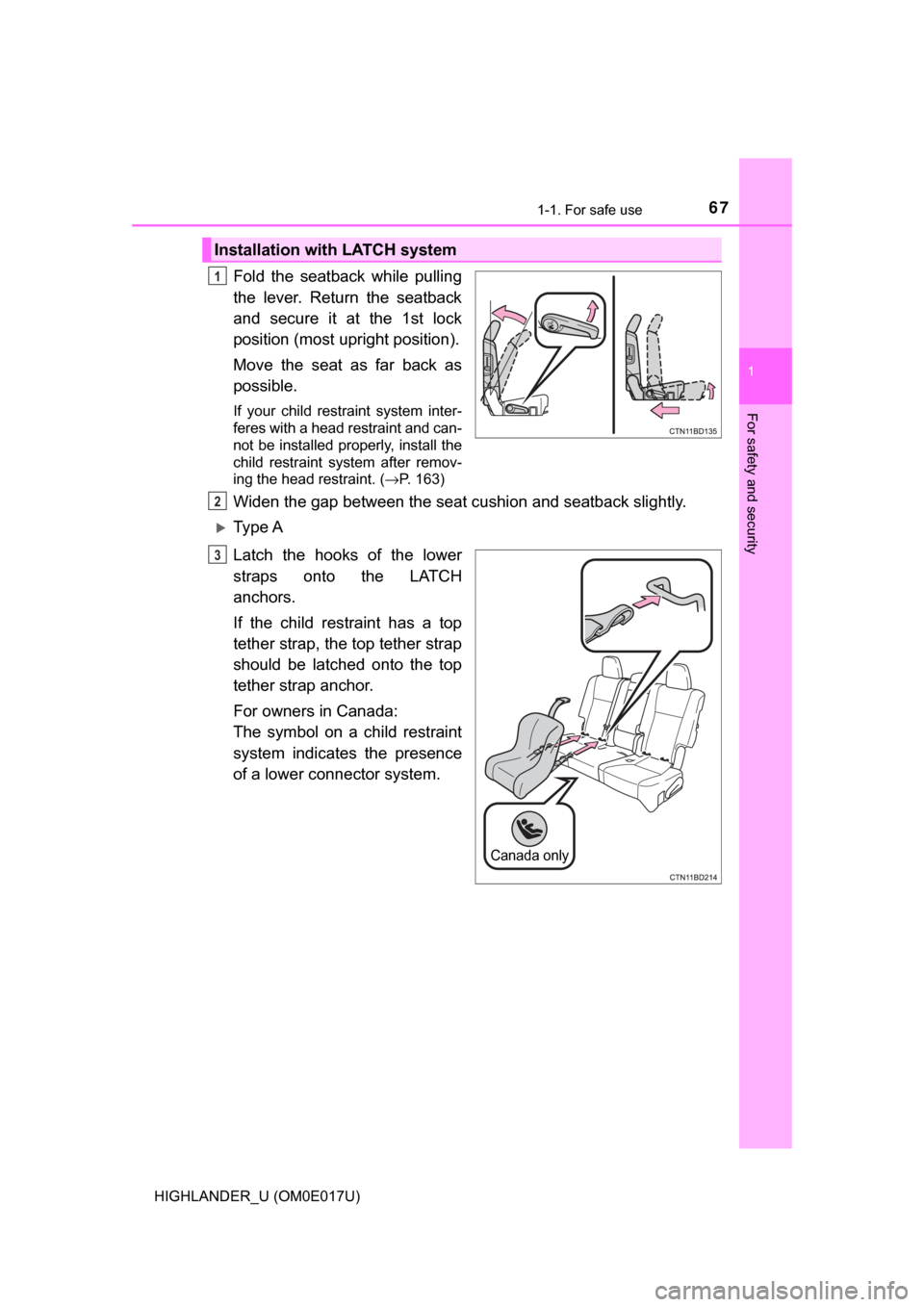
671-1. For safe use
1
For safety and security
HIGHLANDER_U (OM0E017U)
Fold the seatback while pulling
the lever. Return the seatback
and secure it at the 1st lock
position (most upright position).
Move the seat as far back as
possible.
If your child restraint system inter-
feres with a head restraint and can-
not be installed properly, install the
child restraint system after remov-
ing the head restraint. (→P. 163)
Widen the gap between the seat cushion and seatback slightly.
Ty p e A
Latch the hooks of the lower
straps onto the LATCH
anchors.
If the child restraint has a top
tether strap, the top tether strap
should be latched onto the top
tether strap anchor.
For owners in Canada:
The symbol on a child restraint
system indicates the presence
of a lower connector system.
Installation with LATCH system
1
2
Canada only
3
Page 69 of 732
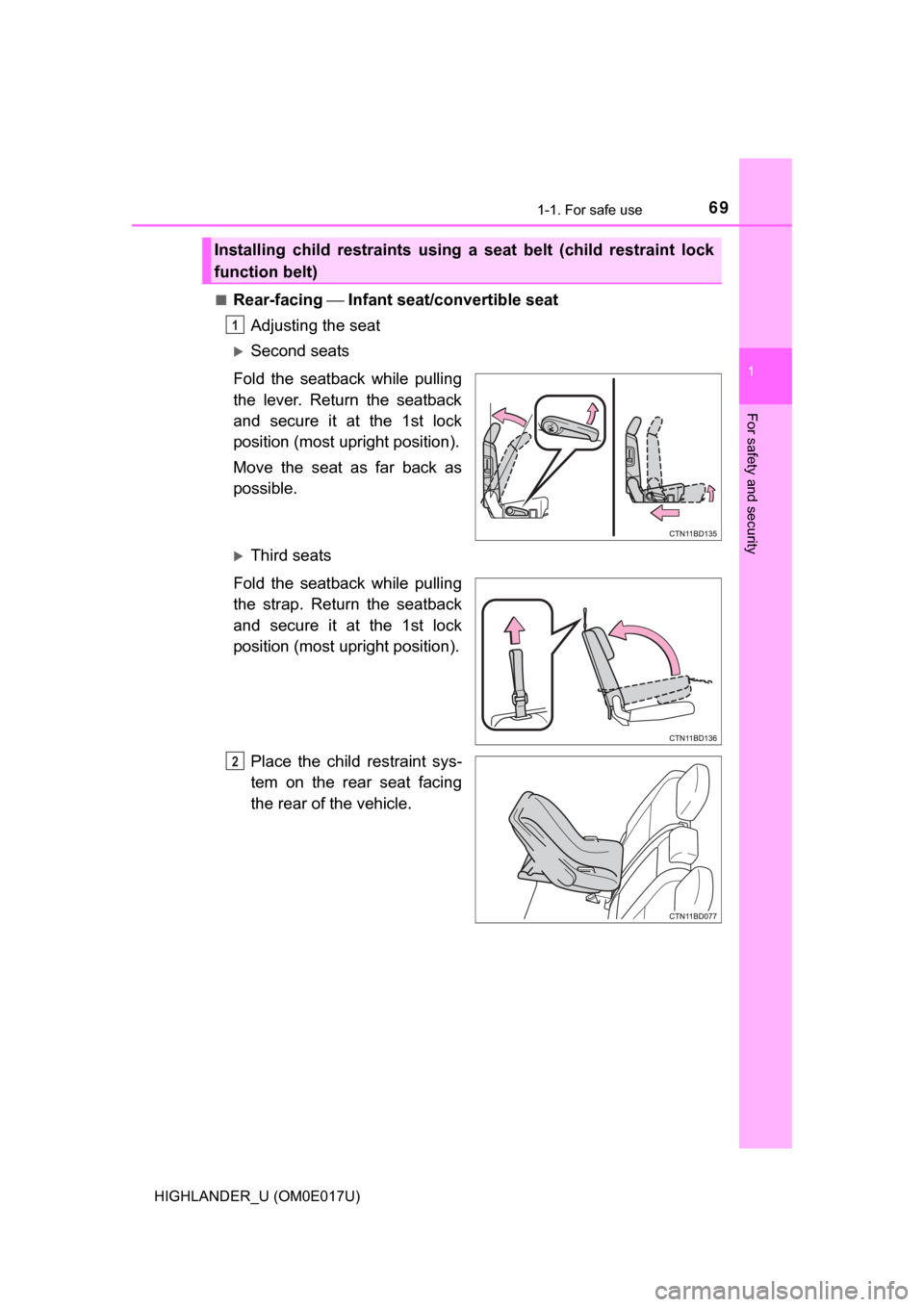
691-1. For safe use
1
For safety and security
HIGHLANDER_U (OM0E017U)■
Rear-facing
⎯ Infant seat/convertible seat
Adjusting the seat
Second seats
Fold the seatback while pulling
the lever. Return the seatback
and secure it at the 1st lock
position (most upright position).
Move the seat as far back as
possible.
Third seats
Fold the seatback while pulling
the strap. Return the seatback
and secure it at the 1st lock
position (most upright position).
Place the child restraint sys-
tem on the rear seat facing
the rear of the vehicle.
Installing child restraints using a seat belt (child restraint lock
function belt)
1
2